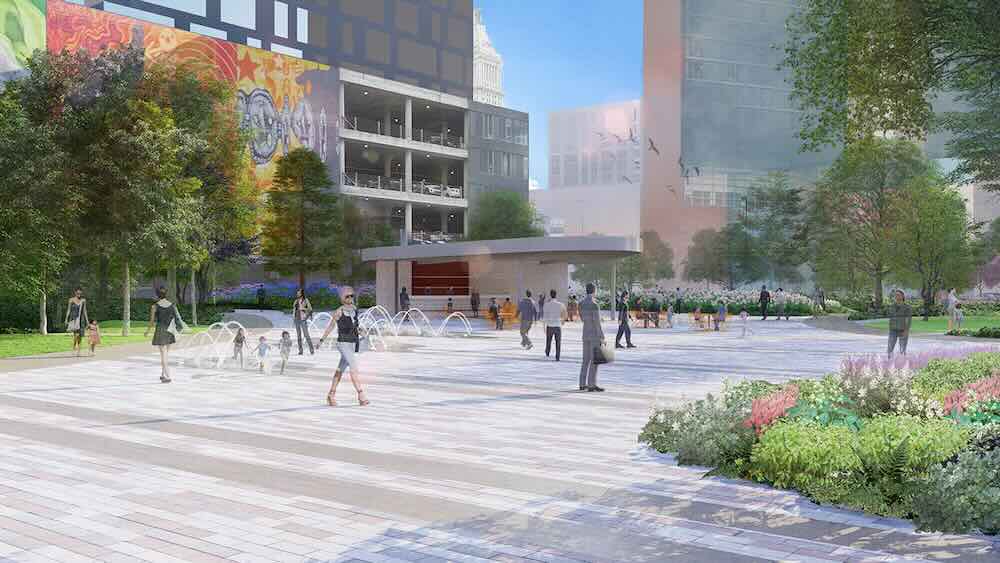


The planned Elm Street Plaza, adjacent to Cincinnati’s Duke Energy Convention Center, will connect eventgoers “directly to downtown, creating a vibrant outdoor space to gather, relax, and experience the city,” said Visit Cincy President and CEO Julie Calvert. “This investment ensures the district feels active and engaging for both visitors and the people who live and work downtown.”
In August, I toured the Duke Energy Convention Center in Cincinnati, Ohio, which is in the final phase of a major 1.5-year renovation and expansion. The facility was still very much a work in progress, but even through the construction dust I could make out a larger vision.
The revamp of the three-story facility isn’t just simply about creating more square footage — although that is a major point of the project: The center will double in size by its grand opening in January 2026, creating a new grand total of more than 200,000 square feet of contiguous exhibit space, a 40,000-square-foot ballroom, plus another about half that size, and plenty of prefunction and concourse space to help maximize flow and flexibility.
But there’s more to the project than that. It’s a linchpin of a larger $1.3-billion redevelopment of the city’s convention district. Led by 3CDC, a nonprofit organization focused on revitalizing Cincinnati’s downtown urban core, the redevelopment aims to bring the area into its next chapter, making it into a more attractive place to work, play, and do business.
In addition to the revamped convention center, plans for the district include a 700-room convention headquarters hotel, opening in 2028. New office buildings have opened, and a new public plaza adjacent to the convention center will welcome visitors in early 2026.
The 2.5-acre Elm Street Plaza is a unique element of the redevelopment plan, creating liminal space between business and pleasure, and acting as something of a bridge between the center itself and the downtown community surrounding it. Tucked between the convention center and a new office building, headquarters for retail data company 84.51, Elm Street Plaza will serve a dual purpose: offer an outdoor space to host attendees meeting at the Duke Energy Convention Center, and when not in use for groups, create a green space open to the public, with a calendar of programming, including community events year-round and an outdoor ice-skating rink in the winter months, designed to draw locals to the area. With a pavilion bar, dog park, water features, and park-like space, the plaza is meant to attract downtown-dwelling office workers and residents frequenting the Fifth Street Corridor, which also includes the popular Fountain Square, where companies like Paycor and Deloitte along with numerous restaurants and retail stores are located.
“Designing Elm Street Plaza as both a convention amenity and a public space brings a new vibrancy to the heart of downtown,” said Visit Cincy President and CEO Julie Calvert. “That dual role not only strengthens Cincinnati’s convention appeal but also creates an everyday energy that keeps downtown more welcoming and dynamic.”
In Good Company
Cincinnati isn’t the only city reenvisioning how mixed-use space around their convention centers can work to their advantage. In Dallas, where officials have already broken ground on a major renovation and expansion of the Kay Bailey Hutchison Convention Center, plans call for a razing of the existing center to make way for a new mixed-use convention district that will also make it easier for attendees to visit surrounding neighborhoods and entertainment districts.
“The idea has been to build a vibrant downtown that has interest, that has restaurants and has facilities for the conventioneers to be drawn into downtown,” Jack Gosnell, senior vice president for CBRE’s Dallas urban retail team, told Commerce + Communities Today. “Before that, conventioneers were getting on buses and going to remote steakhouses outside of the central business district, so the CBD wasn’t getting any of the benefit of the dollars that they would spend in the city.”
Here are three more convention centers that are making mixed-use spaces bolster not just their own business but their local community as well.

From late 2024 through early 2025, artist Radha Chaddah’s ‘Biolumen’ outdoor exhibit took viewers on a journey underwater outside of the Palais in Montreal, which will soon showcase a new art exhibit for Lumino 2026.
Palais des congrès de Montréal – Montréal, Canada
The concept of event venues that double as community spaces is nothing new for Palais des congrès de Montréal. At the start of 2025, the Palais partnered with MT Lab under its Innovative Business in Residence program to offer temporary incubator space in its public area to burgeoning local businesses. The first to seize the opportunity was Espace Recharge, which offers corporate wellness experiences like meditation and yoga, and whose Chambre Immersive “teleports” participants to another place via sounds and images in a closed, cocoon-like space to help reduce stress. The idea is that offering dedicated workspace to entrepreneurs can help them test their concepts in a real-world environment in the Palais’ downtown location, giving them prime visibility since many members of the local business community frequent the public space.
The Palais also regularly hosts art exhibitions as part of its larger goal of embedding itself in the local community. For example, last year the Palais hosted “Biolumen,” an installation by Toronto artist Radha Chaddah and architectural firm RAW Design, during Lumino, an annual festival celebrating winter through art and creative experiences around the city. “Biolumen” — set up outside in front of the Palais’ colorful glass façade — invited visitors and passersby to stop and engage with the installation, which used projections and color to convey the magic of the ocean’s bioluminescent creatures.
- Claim or renew your subscription to Convene.
- Want deep-dive insights on events delivered to your inbox? Sign up for our newsletters.

More than 200 trees were planted in the construction of the New Orleans Ernest N. Morial Convention Center’s pedestrian park.
New Orleans Ernest N. Morial Convention Center – New Orleans
Since 2018, a $557-million, multiphase Capital Improvement Plan for the New Orleans Ernest N. Morial Convention Center has gradually reinvented the city’s convention experience. Many of the upgrades have taken place inside the facility, but how visitors and locals alike connect with the destination at large also has been reimagined, thanks to a new $65-million transportation hub and 7.5-acre pedestrian park, which opened in 2020.
Featuring a linear design that stretches along the entirety of the 11-block-long convention center, the pedestrian park has created a walkable promenade that replaces the previous four lanes of vehicular street traffic. Along it, visitors will find green space dotted with benches, public art, and water features as well as native trees and plants like Louisiana Irises, magnolias, oaks, and sycamores. It’s an idyllic backdrop for entertaining groups along the new porches that line the convention center entrance, or for attendees to pass through while making their way to the neighboring River District, a new mixed-use neighborhood being developed by the Ernest N. Morial New Orleans Exhibition Authority. Spanning 39 acres of dining, retail, housing, and entertainment options along the Mississippi River, the River District has been under construction since 2023, and earlier this year celebrated the groundbreaking of Shell’s new Gulf of America headquarters.

A new six-acre waterfront plaza overlooking the Intracoastal Waterway is nearly ready at the Broward County Convention Center in Fort Lauderdale as part of a $1.3-billion expansion.
Broward County Convention Center – Fort Lauderdale
In Greater Fort Lauderdale, everything seems to happen in, on, or near the water. So it’s no surprise, then, that the Broward County Convention Center’s new outdoor plaza will make its location on the Intracoastal Waterway, which stretches for more than 300 miles in Greater Fort Lauderdale alone, a main character in its renovation.
The six-acre plaza is just one piece of a larger $1.3-billion, multi-phase expansion project, which will provide a breezy backdrop for conventioneers to gather outdoors after a long day in sessions. But its design — which is still being finalized as of August, according to the center’s senior marketing manager, Jorge Solis — will go beyond more than just hosting ancillary events at the center. It will have a “parklike atmosphere” including an amphitheater, restaurants, and a public art installation, the sculpture “Sailfish in Three Stages of Ascending” by Kent Ullberg. When not in use by convention groups, parts of the plaza — specifically the restaurants and amphitheater — will be open to the public. Solis expects that the plaza will open by the end of 2025.
Jennifer N. Dienst is senior editor at Convene.
Read more about convention center expansions designed to encourage community engagement in “Cities Are Calling for Mixed-Use Development to Connect Convention Centers to Their Communities,” a post on the International Council of Shopping Centers’ website at tinyurl.com/ye2k29fn.





